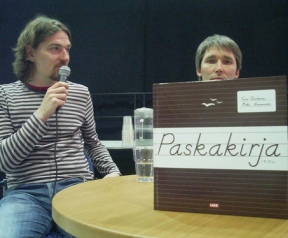Lapko have been amassing a following in Finland for over ten years, and the prognosis is the trio will be alongside fellow "hair band" Disco Ensemble next to break overseas. Malja (vocals and guitar), Nordberg (bass) and Heikkonen (drums) have been friends since they were hanging around the schoolyard in the small town of Harjavalta, where they still gather to rehearse.
They've remained a trio, welded together as a tight, powerful live act and matured from obscure indie faves to a full-fledged rock band with an unpolished sound of their own. "Actually we've regressed, up to the point where you concede you're too dumb to do anything other than play in a rock band,” laughs Nordberg.
Lapko's signature melancholic melodies and Malja's tightly wound vocals have attracted recurring comparisons to Placebo, but the band stands firmly on its own ground. "We moved on from our punk roots towards a broader definition of rock, and, at some point, we were a sort of mix between Rammstein and Placebo with Finnish vocals,” Nordberg recounts. The linguistic issue was reassessed when the vocals on a demo apparently didn't pass as Finnish for a record company.
English seemed more suited for the kind of volatile rock with a raw emotional core that they set out to play. Lapko released their first album, The Arms in 2004 through Tampere-based Jukeboss records, and moved on to Fullsteam Records for their 2006 sophomore effort Scandal.
{mosimage}The new album, Young Desire, celebrates Lapko's regression by going back to the schoolyard and teenage trash talk. "There's a whole leather theme going on; leather being the material of choice for teenage tough guys. It's about being hard and acting like a badass, but still having that insecure and emotional side hidden underneath.”
Following the release, the band will be touring Finland. The theme of acting a role goes further once they hit the stage. "Playing on stage always has an element of theater to it, and we've been looking to Queen for instance, for some inspiration on that,” says Nordberg. The theatrics come across on the album as well, in more stagy compositions. ”We've got guitar solos there.”
In contrast to those young and restless middle-school misfits, Lapko have improved their communication skills as they've grown as a band. They've learned to listen to other people's opinions, including each other's, and they're opening lines of communication to the general public.
A song from the new album can be heard for free over the phone by dialling a certain number. "It won't be released anywhere else as a single, and the phone preview will be available before radio play,” Nordberg explains. The title of the song? "Hugging the Phone"! All you lonely, insecure badasses out there, dial up and start hugging.
Young Desire is released 2nd May. You can catch Lapko live on tour and at various festivals over the summer.
To listent to Hugging the Phone, dial +358 (0) 700 122 55 (cost in Finland 0,10 c/min +local call charge)


